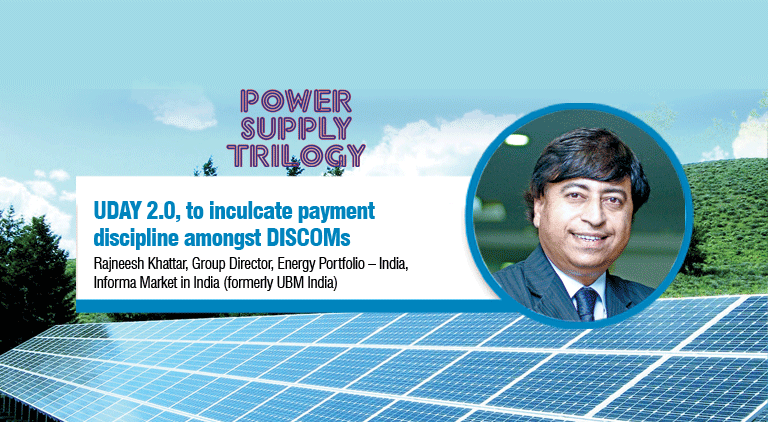UDAY 2.0, to inculcate payment discipline amongst DISCOMs
By EPR Magazine Editorial November 16, 2019 12:02 pm IST
By EPR Magazine Editorial November 16, 2019 12:02 pm IST

More than supply side dynamics, it’s the demand supply projection that should ideally form the basis for the vision by the Power Ministry.
Rajnesh Khattar, Group Director- Energy Portfolio – India, Informa Market in India (formerly UBM India) in an interaction with Athira Bejoy discusses how more than supply side dynamics, it’s the demand supply projection that should ideally form the basis for Power Ministry’s vision.
Moving away from generation and focusing on supply. Your take?
The time has come for this paradigm shift now. High time that supply of power that is generated assumes equal importance and significant progress; should power portfolio need to improvise. Loaded with over capacity of thermal power, coupled with tepid demand and rising share of renewable energy, India is all destined to witness a marked shift towards efficient supply and optimum generation mix. Industries currently facing high power rates will have to focus on last-mile connectivity i.e. power supply and the corresponding infrastructure that it invokes. The two prime reasons for this are no spike in demand from industry which is currently under the weather and financially beleaguered state-owned power distribution companies. More than supply side dynamics, it’s the demand supply projection that should ideally form the basis for the vision by the Power Ministry.
According to PRAAPTI portal, there has been a rise in the outstanding dues to GENCOs by the DISCOMs. Would this move to focus on supply, will bring any relief to the debts?
This definitely is a worrisome frontier that should’ve been anticipated and addressed rather than waiting for it to happen and then finding ways and means to resolve this. It very boldly and loudly clogs the entire generation – supply – consumption cycle with end consumers being the worst affected. Certainly, this new-found and much awaited focus on supply side of the power scenario now will help in better optimisation and rationalisation of the tariff regime. Rationalisation of power tariffs will also bring stability, smoother and uninterrupted supplies. There will be an urge to make on-time payment to ensure cycle doesn’t clot as mutual dependencies between generators, DISCOMs and consumers will be up the rise. Apart from Central Government schemes, investments by DISCOMs and states are critical to strengthen distribution infrastructure and improve systemic efficiencies.
What policy or tariff changes are you expecting to come under the UDAY 2.0 as it is supposedly aimed at improving operations?
UDAY 2.0 is principally developed with the sole aim of resolving DISCOMs’ losses which is the “only difficulty” in ensuring round the clock electricity supply to all. The DISCOMs would have to pay a surcharge for delayed payment, which would be equal to the commercial rate of interest.
DISCOMs are facing one of the greatest threats of cyber attack. In the wake of this, how is an efficient supply possible?
Yes, cyber attacks are yet another critical aspect that needs to be addressed right away. It has the potential to disrupt the cycle and lead to erosion of power supplies for longer durations. However, for an efficient supply chain, it’s imperative to have a technologically robust distribution infrastructure and periodic back-ups. The only way hackers threaten is by sending malicious ransomware and asking for huge sums for furnishing the code to disenable the attacked software. Should our in-house technological systems have requisite backups of consumers’ data from time-2-time, it needn’t even bother to respond to such malwares. However, requisite authorities must be informed as per protocol. The only way forward is to develop one’s own systems to derail the malicious cyber attacks coupled with precautions and drive awareness amongst users.
What kind of infrastructure should be in place for an efficient supply?
A technologically robust, flexible to take loads, especially peak loads, and be accommodative to absorb intermittancy of renewable power is an ideal infrastructure system in my eyes. A system that boasts of reducing AT&C losses as this is the yardstick of efficacy of any distribution network for any country. The infrastructure for enabling an efficient power supply must respond to economic, demographic, fiscal, and environmental changes as it’s so startling to note that AT&C losses are almost three times the amount of power deficit at an all India level.
Rajneesh Khattar,Group Director,
Energy Portfolio – India, Informa Market in India (formerly UBM India)
We use cookies to personalize your experience. By continuing to visit this website you agree to our Terms & Conditions, Privacy Policy and Cookie Policy.